

AD Classics: Santa Maria Church de Canaveses / Alvaro Siza. As is true with most old churches in Portugal, retaining walls, flights of stairs and large forecourts are designed around a building to help maintain it’s distance from its surroundings.

This general strategy is at play in Santa Maria Church in Marco de Canaveses, where Alvaro Siza makes use of the sloping site and lifting the building on a 4m high plateau. More on Alvaro Siza and this classic church after the break. Creating a small urban square, a major intention of both the Santa Maria Church in Marco de Canaveses and planned Parish Center were proposed as buildings that reflect the pre-existing scale of the neighborhood. AD Classics: First Unitarian Church of Rochester / Louis Kahn. Louis Kahn was known for his infusion of culture and creating a sense of place within modern architecture.
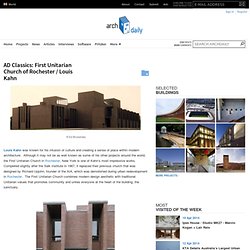
Although it may not be as well known as some of his other projects around the world, the First Unitarian Church in Rochester, New York is one of Kahn’s most impressive works. AD Classics: Luce Memorial Chapel / I.M. Pei. Named after an American missionary of the late 19th century, the Luce Memorial Chapel was added to the campus of Tunghai University in Taichung, Taiwan.

It was designed by Chen Chi-Kwan, an artist and architect, in collaboration with the infamous architect I.M. Pei. More on the Luce Memorial Chapel by I.M. AD Classics: Church at Firminy / Le Corbusier. Known for its striking form and beautiful interior experiences, the Church at Firminy by Le Corbusier was another evolution of the core thoughts and practices of the architect throughout his many years of designing.
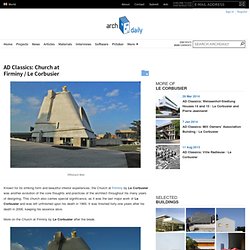
This church also carries special significance, as it was the last major work of Le Corbusier and was left unfinished upon his death in 1965. It was finished forty-one years after his death in 2006, keeping his essence alive. AD Classics: Chapel of the Holy Cross / Richard Hein. The Chapel of the Holy Cross built in the red rocks of Sedona, Arizona is the epitome of what many architects try to achieve when designing religious architecture.
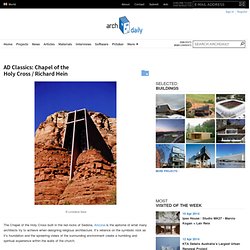
It’s reliance on the symbolic rock as it’s foundation and the sprawling views of the surrounding environment create a humbling and spiritual experience within the walls of the church. The chapel was inspired and commissioned by a student of Frank Lloyd Wright, sculptor Marguerite Brunswig Staude, who worked with project architect Richard Hein and architect August K. Strotz to complete this noteworthy and award winning chapel. AD Classics: Riola Parish Church / Alvar Aalto.
Designed by Finnish architect, Alvar Aalto, Riola Parrish Church is a stunning concrete form which mimics and modulates with the contours of its Italian landscape.
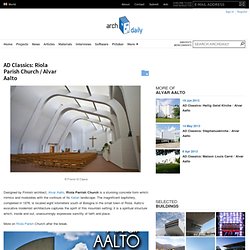
The magnificent baptistery, completed in 1978, is located eight kilometers south of Bologna in the small town of Riola. Aalto’s evocative modernist architecture captures the spirit of this mountain setting; it is a spiritual structure which, inside and out, unassumingly expresses sanctity of faith and place. More on Riola Parish Church after the break. The interior chapel’s play on light is especially divine; the northern light is diffused through vertical, asymmetrical ribs, which create a majestic grid of soft light which projects down onto the worshipper.
AD Classics: St. Mark’s Church in Bjorkhagen / Sigurd Lewerentz. After over a decade of absence from architecture, Sigurd Lewerentz reappeared with the creation of St.
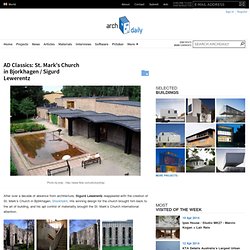
Mark’s Church in Björkhagen, Stockholm. His winning design for the church brought him back to the art of building, and his apt control of materiality brought the St. Mark’s Church international attention. Lewerentz received the commission for St. Mark’s Church through a competition. St. The church is entered through the wooden portico to where one is deposited into a dimly lit foyer. Both buildings on site are made with the same color of brick with a lighter mortar.
St. Architect: Sigurd Lewerentz Location: Stockholm, Sweden Project Year: 1956-60 References: Continuity in Architecture, Sigurd Lewerentz and a Material Basis for Form Photographs: Flickr: jmpt, Wikimedia Commons: Holger.Ellgaard. AD Classics: Bagsværd Church / Jørn Utzon. AD Classics: Holy Cross Church in Chur, Switzerland / Walter Förderer.
Standing at the foot of the Alps is the highly contemporary Holy Cross Church in Chur, Switzerland.
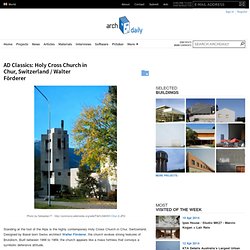
Designed by Basel born Swiss architect Walter Förderer, the church evokes strong features of Brutalism. Built between 1966 to 1969, the church appears like a mass fortress that conveys a symbolic defensive attitude. The polygonal tower at the south west corner of the building is the dominant feature that contains four bells: the trinity bell, the cross bell, the peace bell, and the Marien bell. The Roman Catholic Church was assembled through a layered concrete construction, with dominant uneven forms tying in and out of each other.
The dark semi-circular interior was built entirely out local concrete and wood materials that contrast with each other creating a powerful sacred space. Architect: Walter Förderer Location: Chur, Switzerland Project Year: 1966-1969 References: Magsmag Photographs: Wikimedia user: Sebastian F, Blogspot user: kylähullu, Tumbler user: Magnus. AD Classics: St. John’s Abbey Church / Marcel Breuer. Saint John’s Abbey Church was designed by the renowned Hungarian architect Marcel Breuer.

This cast-in-place concrete marvel is a stepping-stone in modern design of religious architecture in the United States. AD Classics: Colònia Güell / Antoni Gaudí. Colònia Güell was a workers’ colony located in Santa Coloma de Cervelló, presently a town of around 7,000 inhabitants 20km outside Barcelona.

The area was a manufacturing suburb that grew rapidly around the turn of the 20th century. In 1898, Antoni Gaudi was commissioned by Count Eusebi de Güell, who wanted to provide a place of worship for the booming suburb, to build a Church. It was never actually completed because the money ran out as a result of economic hardships. When work stopped in 1915, only the crypt was completed, though it is nevertheless listed by UNESCO as a world heritage site. In 2002, a restoration was carried out by architect Antonio González Moreno who was widely criticized for allegedly mistreating Gaudi’s work. Through the construction process of Colònia Güell, Gaudi is said to have experimented with an array of techniques and architectonic details, many of which would later be used in his famous tour-de-force, the Sagrada Familia in Barcelona.
AD Classics: Cathedral of Brasilia / Oscar Niemeyer. AD Classics: Ronchamp / Le Corbusier. In the commune of Ronchamp, slightly south of east of Paris, sits one of Le Corbusier’s most unusual projects of his career, Notre Dame du Ronchamp, or more commonly referred to as Ronchamp. In 1950, Le Corbusier was commissioned to design a new Catholic church to replace the previous church that had been destroyed during World War II.
The site of Ronchamp has long been a religious site of pilgrimage that was deeply rooted in Catholic tradition, but after World War II the church wanted a pure space void of extravagant detail and ornate religious figures unlike its predecessors. Ronchamp is deceptively modern such that it does not appear as a part of Corbusier’s aesthetic or even that of the International Style; rather it sits in the site as a sculptural object. AD Classics: The Cathedral of St. Mary of the Assumption / Pietro Belluschi and Pier-Luigi Nervi.